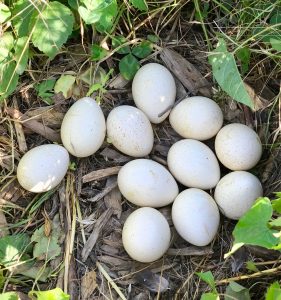 There’s an abundance of wild turkeys on our farm. We see them through all seasons. This summer our grazing cows found a turkey nest containing 11 eggs. A nesting hen at this time of year is considered late and we anticipated that the eggs were not fertilized. Still, we moved the temporary fence to ensure her safety and that of the eggs.
There’s an abundance of wild turkeys on our farm. We see them through all seasons. This summer our grazing cows found a turkey nest containing 11 eggs. A nesting hen at this time of year is considered late and we anticipated that the eggs were not fertilized. Still, we moved the temporary fence to ensure her safety and that of the eggs.
I was hoping for the best and went back to take a peek a few days later. The hen flew away. We were both startled even though I anticipated her departure flight. I decided to wait a few days until my next visit. I didn’t want to disturb her or bring attention to other animals that there was a nest. On my last visit, I noticed a peck on an egg with another egg exposing what appeared to be an eye. I could hardly contain my excitement and rushed to inform my friends.

The wild turkeys have excellent nesting habitat choices in our hayfields, orchards and dense wooded areas. They have multiple food sources and the new mothers look for the highest protein available. Most likely, insects and we have plenty available. I hope they take all of them but I know that this is wishful thinking. In the past summers we’ve noticed hens beating weeds with their wings to push insects out for the little ones to collect and eat. In addition to the bugs, they enjoy the many acorns and hickory nuts that are prevalent on our farm. They also like the wild berries abundantly available around the forest’s edge. They seem to find them before I can pick for my consumption.
In our part of the country (southern Pennsylvania) we have the eastern wild turkey. According to the Pennsylvania State University’s web site, “This is the most widely and abundant sub-species of the fives types of wild turkeys.” They also noted that a single gender flock ranges in size from 5 to 50 individuals. They’re not kidding. We’ve seen flocks on our farm ranging from a few to 40 plus. An amazing sight to behold in the early morning when they’re feeding on the pastures. A flock will hear and see me immediately when I happen to find them. Then off they’ll dash to safety in the woods within seconds.
The hen takes great care in selecting a site and protecting her nest. They’ll scratch a one square foot depression in the soil, then squat and lay their eggs. They have one brood per summer with an incubation period of about a month. The mother will stay on her nest most of the time, leaving only to feed herself. At night she sits and protects her nest from predators and during a hot day, she’ll shade the eggs from overheating or from bad weather conditions.
About a day after the eggs hatch, the mother will guide the chicks away from the nest. She also protects them under her wings if she senses danger. I’ve not been fortunate to see this, but I’ve witnessed this protective care with our chickens. The poults or youngsters are never far from their mother. By fall, the young flock is ready to integrate within the larger community of turkeys.
The nest I found only had one egg that hatched. It was a bittersweet moment for I wanted them all to survive. Thankfully, nature ensures that next spring we will have many more nests and poults running about.
For more information, please check out one of the sites below:
- http://www.nwtf.org/hunt/wild-turkey-basics/lifestyle-breeding
- https://www.allaboutbirds.org/guide/Wild_Turkey/id
- http://www.audubon.org/field-guide/bird/wild-turkey